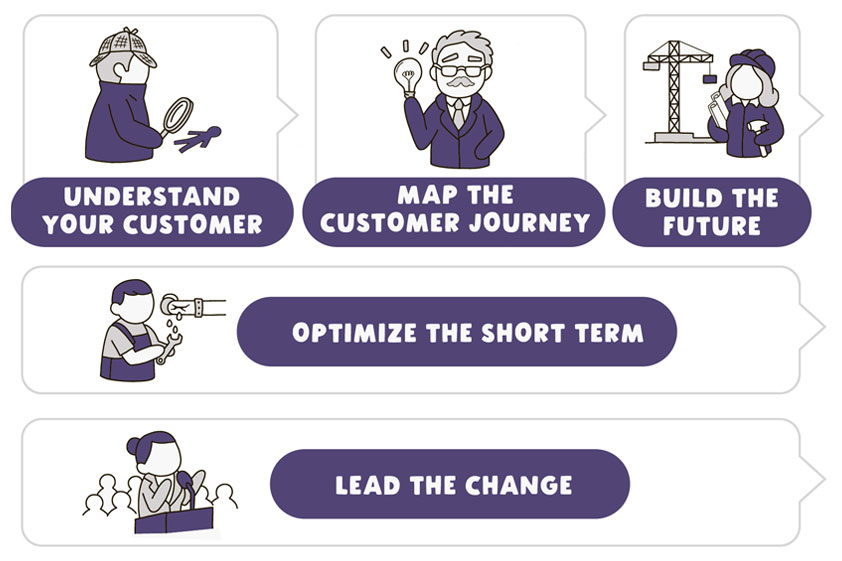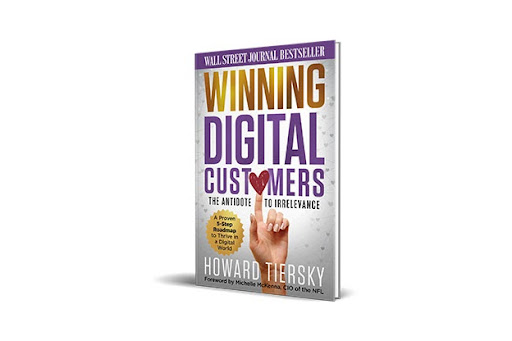Insights | By Howard Tiersky
DOMINO’S NEAR-DEATH EXPERIENCE, SAVED BY DIGITAL TRANSFORMATION
Can a pizza chain go from almost bankrupt to a digital giant in just a few years? Domino’s certainly did, and they don’t look like they’re slowing down anytime soon.
This article will talk about how Domino’s taught themselves some new tricks and how other companies can do the same.
DOMINO’S WAS DYING
In 2008, Domino’s was $1.7 billion in debt, losing domestic franchisees by the dozens, and suffering massive blows to their brand image due to the quality of their pizza. These issues caused their stock to drop below $3 per share.
It was at this time that Domino’s decided to fight back by developing a robust digital strategy as well as improving the quality of their products.

UNDERSTAND THE CUSTOMER
Domino’s needed to know what would make a difference for their customers so they leveraged social media to engage their community, giving customers an avenue to share their opinions of the company and offer possible solutions. Domino’s took notes, and the most popular ideas, solutions, and opinions were rewarded with money.
Aside from online engagement, the company also examined consumer habits and looked closely at when and where people usually place orders, the issues they encounter while ordering, and their rapidly changing expectations as technology evolves.

FOCUS ON FAST ORDERING
Domino’s had historically differentiated on the speed of their pizza delivery, but after studying customer behavior, they discovered that they had to make the speed of ordering a priority as well.
Customers found the company’s web-based ordering system too complicated. The entire process often took more than 25 steps, from the time a customer lands on the homepage to when they finally place their order.
Friction burns customers; the longer it took for people to order a pizza, the less likely they were going to complete their purchase.
With this key insight in mind, Domino’s set the ambitious goal of making it so fast to order a pizza that customers could do so while waiting for the train, stopped at a red light, or on a quick pause from their video game.
To reduce the ordering steps, the company introduced the Pizza Profile and Easy Order features, which stored customers’ personal information and favorite pizza orders so they won’t have to enter the same details every time they order.
Domino’s made further iterations to their ordering process and eventually launched an app that allowed customers to order through a variety of digital channels, including by simply tweeting a pizza emoji to Domino’s Twitter account.
They also introduced the Zero Click app, a mobile application that allows customers to order pizza without having to tap, click, or swipe. Once opened, it displays a ten-second timer before sending the user’s default pizza order.

BUILD ENGAGEMENT
Aside from maximum convenience, Domino’s recognized that customer engagement is another key component of the overall experience. Engaging with customers makes them feel in control of the transaction and builds up anticipation for the product.
The company created the Pizza Builder, which offers a visually appealing way for customers to select their preferred crust, sauce, and toppings and see their customized pizza take form on the computer screen.
Another digital tool for engagement is the Pizza Tracker, which allows customers to monitor the progress of their order online from the time it’s placed until its delivery. The order tracking system was a novel way of sharing the entire pizza-making process with the public, and it became a huge success, boosting online ordering profits by 23%.
Domino’s was able to turn a mundane thing–waiting for a food order–into a positive experience as customers, and families with children in particular, excitedly followed the progress of their pizza.

MANAGE RESISTANCE TO CHANGE
To make the Pizza Tracker work for all their stores, Domino’s needed to establish a new point-of-sale system that could accommodate the requirements of the order tracking feature.
This new system was met with strong resistance by some of the company’s franchisees, and they filed a lawsuit to stop it. The franchisees were already using a third-party system for their stores, and changing it would mean incurring significant costs and additional training for their staff.
The courts eventually ruled in Domino’s favor, which meant the company could have required all store owners to use the new platform. But instead of just relying on a court ruling, Domino’s made an effort to understand and address their franchisees’ concerns.
The company was able to demonstrate how the new technology made store operations more efficient and less expensive, which would make the additional costs worthwhile in the long run. This made the franchisees more amenable to adopting the new system, and they moved forward with far better alignment.
DOMINO’S TODAY
As a result of their efforts, Domino’s has seen a consistent increase in their global net income year over year, growing from $80 million in 2009 to $510 million in 2021. From a struggling legacy organization, they became a leading digital innovator that consistently delivers exceptional experiences for customers.
HOW CAN OTHER COMPANIES TRANSFORM?
Domino’s was able to achieve massive success after reinventing their customer experience for the digital age. This level of success is entirely within reach as well for other companies through the powerful impact of digital transformation.
At FROM: The Digital Transformation Agency, we have worked with many large brands such as NBCUniversal, JPMorgan Chase, Avis, and Airbus to help strategize and launch successful digital solutions that transformed their customer experience and attained their business goals.
Through our collaboration with these companies, From identified five key steps that organizations take to implement a successful digital transformation.
This five-step approach is explained in more detail in our Wall Street Journal bestselling book, Winning Digital Customers: The Antidote to Irrelevance, but here’s a summary that illustrates how companies like Domino’s were able to execute digital change.


1. CONDUCT CUSTOMER RESEARCH
To gain key insights on their customer experience, Domino’s relied in part on social media, which can be an effective tool for gathering customer feedback. There are a variety of software platforms that can help companies aggregate data from social media to analyze customer sentiment.
Domino’s also made use of customer data analytics to delve deeper into customers’ interactions with the brand in order to better understand their pain points.
These methods are just some of the valuable tools in the customer research arsenal. Depending on their needs, organizations can utilize other options such as customer surveys, interviews, and observational research.
Observational research involves paying close attention to how customers use a product or service and asking them to verbalize their thoughts throughout the process. This method is particularly effective because it captures first-hand information on the customers’ needs, preferences, and problems as they are going through the customer experience.

2. CREATE A CUSTOMER JOURNEY MAP
When Domino’s set their sights on making the ordering process much faster and easier, they first needed to understand the customers’ end-to-end experience of ordering a pizza. Using this data, the company then had to envision a new experience that would deliver greater convenience and seamlessly weave into the customers’ daily lives.
Other businesses can also drive more impactful results in their own transformation by using a customer journey map—a diagram that outlines the key steps that customers go through when they interact with a brand.
This tool enables companies to evaluate their current process, identify opportunities for adding value, and make changes to improve customer engagement while meeting business needs.
There are two major steps in creating a customer journey map–outline the current customer experience and compose an ideal future experience.
Current-state journey mapping starts with breaking down the customer experience into multiple stages, from identifying a need that pushes people to shop and make a purchase to using the product and sharing their experience with others.
This is followed by collecting customer stories that fit into each stage of the journey, creating a diagram that lays out the entire customer journey, and prioritizing the pain points throughout the journey that need to be addressed.
Once the current-state map is fully fleshed out, the future-state customer journey can be built. Crafting a vision of the ideal customer experience involves defining the company’s desired business outcomes and ideating possible solutions to customer pain points.
The most feasible ideas are then prioritized and translated into optimal user experience stories. These stories are conveyed through engaging visuals, which can help sell the vision of this future-state customer journey to the entire organization to get them on board.

3. INCORPORATE DESIGN THINKING PRACTICES
Domino’s ordering system is simple and intuitive yet also versatile enough to provide multiple ordering channels, from a tweet to a zero-click app. This was achieved through a meticulous, iterative process of ideation, analysis, designing, and testing to make sure that each component contributes to a positive user experience.
Just like Domino’s, other companies can also build customer-centric digital solutions through design thinking. While the journey map provides an overview of the ideal customer experience, design thinking gets into the details of how each element of the experience needs to be crafted in order to achieve customer satisfaction.
The design thinking approach has three primary stages. The first one involves identifying desired business outcomes, determining the customer problems that need to be solved to reach those outcomes, and understanding market competitors and the alternatives they offer.
The second stage is ideation, a process of generating and organizing ideas while stretching the team’s imagination to come up with innovative solutions.
In the final step, these ideas need to be prioritized based on what is desirable for the customer, viable for the business, and most feasible to accomplish using available resources. After that, it’s a process of prototyping, testing, building, launching, and iterating until success.

4. OPTIMIZE THE SHORT TERM
Domino’s Pizza Builder and order-with-an-emoji features are prime examples of short-term solutions that helped the company turn things around while they were implementing large-scale changes to their operations.
Domino’s made use of their existing order management system to quickly launch these features to market at relatively low cost even as they were working on other aspects of their digital innovation program.
Digital transformation involves a substantial time commitment, but companies can still make small changes that have immediate impact. This can be done by identifying underperforming areas of the business that can be turned around quickly and leveraging existing assets to make improvements in these areas.

5. LEAD THE CHANGE AND MANAGE RESISTANCE
While Domino’s had the legal authority to force franchisees to use their POS system, they didn’t just resort to an authoritarian method of implementing the change.
Instead, the company listened to their franchisees and was able to show them that the benefits of the new technology far outweighed the costs. This paved the way for a smoother adoption process.
Managing change is not just about “defeating” everyone who is against it but about getting the outcome that the change is trying to reach, which in Domino’s case was to create a unified experience in one platform.
To overcome organizational resistance to change, companies need to find common ground with other stakeholders, address the issues that are holding people back from supporting the change, and communicate a compelling vision of the future that will inspire them to participate.
MORE EXAMPLES OF DIGITAL TRANSFORMATION
From used used the same five-step process in helping scores of our clients implement digital change and deliver an outstanding customer experience. Here are three of our success stories:
- Like Domino’s, the American Automotive Association (AAA) wanted to provide a more convenient customer experience. To help them achieve this, FROM conducted customer research, created a journey map, and designed a new roadside app that made it easier for AAA customers to receive assistance while reducing the number of inbound calls to the company’s call center. The outcome was a massive increase in digital requests for roadside assistance (vs calls) and increased customer satisfaction.
- The five-step approach doesn't only apply to B2C brands; FROM has also worked with B2B businesses such as Airbus to upgrade their digital customer experience. In this collaboration, FROM helped Airbus build an e-commerce solution so that customers can easily order on-demand, custom aerial photography taken by Airbus’s state-of-the-art satellites.
- Providing a high degree of convenience and speed to employees is essential for companies as well. FROM worked with NBCUniversal to modernize their HR dashboard, enabling employees to access their personal data and career information on a user-friendly platform.
Looking to drive digital change in your own organization?

My Wall Street Journal bestselling book, Winning Digital Customers: The Antidote to Irrelevance, contains a blueprint for developing a successful strategy for your company as well as practices to aid in identifying new trends and opportunities to explore. You can download the first chapter for free here or purchase the book here.











